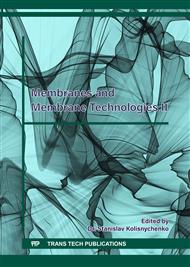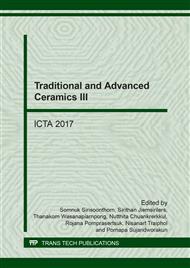p.44
p.51
p.58
p.65
p.71
p.77
p.83
p.88
p.94
Effect of Peptizing Agent Concentration on Morphology of Unsupported Alumina Membrane
Abstract:
Ceramic membranes have received significant attention from both academia and industry, as they show the great potential in several important applications such as H2 separation, recovery of CO2 from natural gas and reduction of green-house gas emission from flue gas. The aim of the present study was to evaluate the effect of peptizing agent concentration on morphology of unsupported alumina membranes that are suitable for gas separation. The unsupported alumina membranes were prepared by the sol-gel method using aluminum-tri-sec-butoxide as a precursor and acetic acid as a peptizing agent. The particle size distributions of produced boehmite sols, as measured by dynamic light scattering technique, range from 10 to 600 nm. The increase in the concentration of acetic acid results in formation of particles of smaller median diameter. The pore volume and size distribution of unsupported alumina membranes were characterized by the Brunauer–Emmett–Teller (BET) method of adsorption of nitrogen gas. The pore size distributions of membranes were rather narrow in the range of 3 to 6 nm. The average diameter and volume of pores increase and the surface area decreases while the concentration of acetic acid increased.
Info:
Periodical:
Pages:
71-76
Citation:
Online since:
April 2018
Authors:
Keywords:
Price:
Сopyright:
© 2018 Trans Tech Publications Ltd. All Rights Reserved
Share:
Citation:



